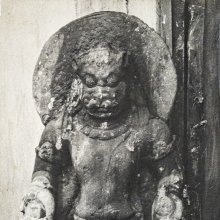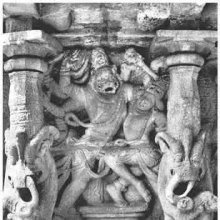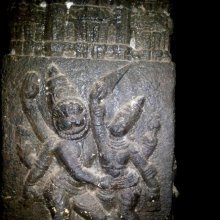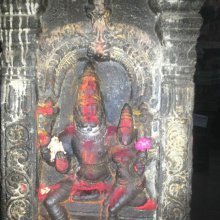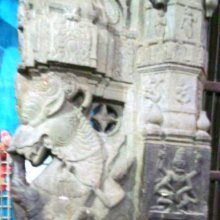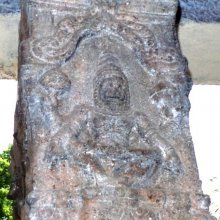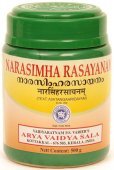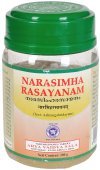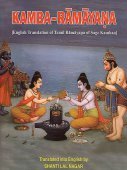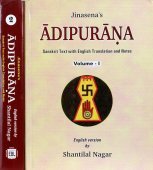Narasimha, Nara-simha, Narasiṃha, Nārasiṃha, Narasingha: 46 definitions
Introduction:
Narasimha means something in Buddhism, Pali, Hinduism, Sanskrit, Jainism, Prakrit, the history of ancient India, Marathi, biology. If you want to know the exact meaning, history, etymology or English translation of this term then check out the descriptions on this page. Add your comment or reference to a book if you want to contribute to this summary article.
Images (photo gallery)
(+17 more images available)
In Hinduism
Natyashastra (theatrics and dramaturgy)
Source: archive.org: The mirror of gesture (abhinaya-darpana)One of the Daśāvatāra (Hands of the Ten Avatars of Vishnu).—Narasiṃha: left hand–Siṃha-mukha, right hand–Tripatāka.
Source: Shodhganga: Elements of Art and Architecture in the Trtiyakhanda of the Visnudharmottarapurana (natya)Narasiṃha (नरसिंह) or Narasiṃhāvatāra refers to one of the Daśāvatāra (“ten incarnations”) (of Lord Viṣṇu) to which are assign various hand gestures (in Indian Dramas), according to the Viṣṇudharmottarapurāṇa, an ancient Sanskrit text which (being encyclopedic in nature) deals with a variety of cultural topics such as arts, architecture, music, grammar and astronomy.—In the Hindu scriptures, different stories are found, related to lord Viṣṇu, where we find the magnanimity of different incarnations of lord Viṣṇu. Moreover, a great influence of these ten incarnations of lord Viṣṇu (e.g., Narasiṃha-avatāra) seems to fall in the field of Dance also.

Natyashastra (नाट्यशास्त्र, nāṭyaśāstra) refers to both the ancient Indian tradition (shastra) of performing arts, (natya—theatrics, drama, dance, music), as well as the name of a Sanskrit work dealing with these subjects. It also teaches the rules for composing Dramatic plays (nataka), construction and performance of Theater, and Poetic works (kavya).
Purana and Itihasa (epic history)
Source: archive.org: Puranic EncyclopediaNarasiṃha (नरसिंह).—See under Avatāra.
Source: Cologne Digital Sanskrit Dictionaries: The Purana Index1) Narasiṃha (नरसिंह).—The avatār of Hari to kill Hiraṇyakaśipu by the nails neither wet nor dry;1 on Brahmā granting the request of Hiraṇyakaśipu, Narasimha was approached by the gods; Narasimha promised to slay him and left for the sabhā of Hiraṇyakaśipu; Prahlāda alone knew Him to be the Lord; all the Asuras attacked him from all sides; finally Narasimha killed him by tearing him with his teeth.2
- 1) Brahmāṇḍa-purāṇa III. 5. 26-27; 57. 57; 73. 74; Vāyu-purāṇa 67. 66; 97. 73; 98. 73; 111. 72; Viṣṇu-purāṇa I. 20. 32.
- 2) Matsya-purāṇa 53. 50. chh. 161, 162 and 163; 285. 6.
2a) Nārasiṃha (नारसिंह).—(also Narasimha and Nṛsimha) the fourteenth among the avatārs of Viṣṇu; the first among the twelve avatārs; vanquished the Asura king with the help of oṅkāra bearing him like a mat-maker tearing the reeds.*
- * Bhāgavata-purāṇa I. 3. 18; Brahmāṇḍa-purāṇa I. 1. 128; III. 72, 73 and 76; Matsya-purāṇa 22. 17; 47. 42, 46; 161. 37; Vāyu-purāṇa I. 151; Viṣṇu-purāṇa IV. 14. 47; 15. 4.
2b) The image of; with eight hands, with the Asura below vomitting blood.*
- * Matsya-purāṇa 259. 2; 260. 31.
2c) The 16th kalpa.*
- * Matsya-purāṇa 290. 7.
2d) A tīrtha sacred to the Pitṛs.*
- * Matsya-purāṇa 22. 43.
2e) The upapurāṇa of 18,000 verses belonging to the Pādmam.*
- * Matsya-purāṇa 53. 60.
Narasiṃha (नरसिंह) or Narasiṃhapurāṇa refers to one of the eighteen Minor Puranas (i.e., Upapurāṇa) according to the Kūrmapurāṇa and other traditional lists of Puranic literature: a category of ancient Sanskrit texts which gives a huge contribution in the development of Indian literature.—The Upapurāṇas (e.g., narasiṃha-purāṇa) can be considered as the supplements of the Mahāpurāṇas as those are mostly based on the Mahāpurāṇas. The Saurapurāṇa considers the Upapurāṇas as khilas i.e., supplements. [...] Though the numbers of Upapurāṇas are specified as eighteen, there are many important Upapurāṇas which are excluded from the lists of Upapurāṇas given by different sources.

The Purana (पुराण, purāṇas) refers to Sanskrit literature preserving ancient India’s vast cultural history, including historical legends, religious ceremonies, various arts and sciences. The eighteen mahapuranas total over 400,000 shlokas (metrical couplets) and date to at least several centuries BCE.
Vastushastra (architecture)
Source: archive.org: Catalogue of Pancaratra Agama Texts (vastu)Narasiṃha (नरसिंह) is the name of a deity situated in the South on the Vimāna, as discussed in chapter 13 of the Ādikāṇḍa of the Hayaśīrṣasaṃhitā: a large Pāñcarātra Āgama consisting of roughly 6500 verses dealing primarily with architecture, temple-building and consecration rituals and iconography.—Description of the chapter [prāsādalakṣaṇa-paṭala]: [...] Then the comparative heights of various parts of the temple are discussed (25-27). This is followed by a brief discussion of where the various deities should be located on the vimāna (?)—Mahāvarāha in the East, Narasiṃha in the South, Śrīdhara in the West, Hayaśīrṣa in the North, Jamadagni in the Southeast, Rāma in the Southwest, Vāmana in the Northwest and Vāsudeva in the Northeast. [...]
Source: Shodhganga: Temples of Salem region Up to 1336 ADNarasiṃha (नरसिंह).—The Narasiṃha rock-cut shrine is rectangular on plan. An elevated square platform projects from the rear wall. This platform has a pādabandha-adhiṣṭhāna and four pillars. In between the pilasters on the rear wall, the main deity is sculpted. This is a seated figure of Kevala Narasiṃha shown in abhayamudra. The left hand is stretched and rests on the knee.
On the two sides of the main deity, sculptures of Sūrya, Candra, Śiva and Brahmā are carved. There are two celestial figures carved near the ears of Narasiṃha, who are identified as Sanaka and Sanandana.

Vastushastra (वास्तुशास्त्र, vāstuśāstra) refers to the ancient Indian science (shastra) of architecture (vastu), dealing with topics such architecture, sculpture, town-building, fort building and various other constructions. Vastu also deals with the philosophy of the architectural relation with the cosmic universe.
Shilpashastra (iconography)
Source: archive.org: Pratima Kosa Encyclopedia of Indian Iconography - Vol 6Nārasiṃha (नारसिंह) refers to one of the many varieties of the Śālagrāma (ammonite fossil stones).—The Nārasiṃha stone has a wide opening like an open mouth (ati-vistṛtāsya); tawny-coloured (kapila); a line above the opening and another in the middle of the stone; two cakras; three or five spots inthe lower portion. Śālagrāma stones are very ancient geological specimens, rendered rounded and smooth by water-currents in a great length of time. They (e.g., Nārasiṃha stones) are distinguished by the ammonite (śālā, described as “vajra-kīṭa”, “adamantine worms”) which having entered into them for residence, are fossilized in course of time, leaving discus-like marks inside the stone.
Source: archive.org: Catalogue of Pancaratra Agama Texts (shilpa)Narasiṃha (नरसिंह) refers to one of the Daśāvatāras (“ten avatāra-incarnations”) whose iconographic details are discussed in chapter 23 of the Ādikāṇḍa of the Hayaśīrṣasaṃhitā: a large Pāñcarātra Āgama consisting of roughly 6500 verses dealing primarily with architecture, temple-building and consecration rituals and iconography.—Description of the chapter [daśa-avatāra-pratimā-lakṣaṇa]: This chapter turns to the general iconographical directions for making the ten avatāra-forms [e.g., Narasiṃha (15-23)] [...] Note that Kṛṣṇa is omitted from this list.
Source: Shodhganga: The significance of the mūla-beras (śilpa)1) Narasiṃha (नरसिंह) or Narasiṃhāvatāra refers to one the “ten incarnations of Lord Viṣṇu”, as defined according to texts dealing with śilpa (arts and crafs), known as śilpaśāstras.—The hand gestures for the daśāvatāra in dancing and iconography are similar in some cases and dissimilar in most of the cases. In dance, the Narasiṃha-avatāra is depicted when the left hand assumes siṃhamukha-hasta and the right hand assumes tripatāka-hasta. Another way of representing the narasiṃha avatāra is one in which the dancer standing on one leg holding vardhamāna or recita hastas (nṛtta-hastas). Followed by the vardhamāna there is a sequence of hastas following each hasta. The añjali-hasta is held at the head and the face is turned aside. Then the hands hold patāka-hastas and they are thrown out with a shake to denote valour; the body is then extended forward, denoting puruṣamṛga (half man and half beast). In iconography, the image of Viṣṇu is also depicted as a terrible giant with a lion’s head.
2) Narasiṃha (नरसिंह) is the name of a deity depicted at the Kallazhagar Temple in Madurai, which represents a sacred place for the worship of Viṣṇu.—Narasiṃha is found in yogāsana posture with four hands. The upper hands are in kartarīmukha-hasta in which the conch and the discus are held. The lower hands are in dolā-hasta. While representing in dance, Narasiṃha is found seated in nāgabhanda posture with four hands. The upper hands are in kartarīmukha-hasta and the other two hands are in dolā.

Shilpashastra (शिल्पशास्त्र, śilpaśāstra) represents the ancient Indian science (shastra) of creative arts (shilpa) such as sculpture, iconography and painting. Closely related to Vastushastra (architecture), they often share the same literature.
Chandas (prosody, study of Sanskrit metres)
Source: Shodhganga: a concise history of Sanskrit Chanda literatureNarasiṃha (नरसिंह), alias Nṛsiṃha Bhāgavata, is the author of the Vṛttaratnārṇava. Narasiṃha is the son of Cinna Veṅkaṭasūri and Vīrammā and disciple of Rāmānandayogīndra. He was also the resident of Vepattur village, presently a village of Tanjavur district of Tamilnadu. The Vṛttaratnārṇava is the lone work to his credit. Narasiṃha himself says the name of his parents, preceptor and place in the colophon of this text, from where it is understood that Narasiṃha was a native of Tamilnadu. Narasiṃha praises the lotus feet of his preceptor, which bestow the puruṣārtha to his disciples. As the milk-ocean brings pleasure to Lord Hari, the text Vṛttaratnārṇava composed by Nṛsiṃha would bring to Lord Hari.

Chandas (छन्दस्) refers to Sanskrit prosody and represents one of the six Vedangas (auxiliary disciplines belonging to the study of the Vedas). The science of prosody (chandas-shastra) focusses on the study of the poetic meters such as the commonly known twenty-six metres mentioned by Pingalas.
Shaivism (Shaiva philosophy)
Source: Shodhganga: Iconographical representations of ŚivaNārasiṃha (नारसिंह) or Nārasiṃhāgama refers to one of the upāgamas (supplementary scriptures) of the Kāmikāgama which is one of the twenty-eight Siddhāntāgama: a classification of the Śaiva division of Śaivāgamas. The Śaivāgamas represent the wisdom that has come down from lord Śiva, received by Pārvatī and accepted by Viṣṇu. The purpose of revealing upāgamas (e.g., Nārasiṃha-āgama) is to explain more elaborately than that of mūlāgamas (e.g., Kāmika-āgama) and to include any new idea if not dealt in mūlāgamas.
Source: SOAS University of London: Protective Rites in the Netra TantraNarasiṃha (नरसिंह) refers to a form of Viṣṇu, according to the Netratantra of Kṣemarāja: a Śaiva text from the 9th century in which Śiva (Bhairava) teaches Pārvatī topics such as metaphysics, cosmology, and soteriology.—Accordingly, [verse 13.1-9, while describing the appearance and worship of Viṣṇu]—“Or, [the Mantrin] worships a very handsome, eight-armed, yellow Deva. [...] He remembers [Viṣṇu’s] many forms. Thus, he thinks [of him] with a collection of many faces, many weapons and [many] arms [i.e., the cosmic Viṣṇu], reclining, taking a wife, joined with Lakṣmī, alone, [as] Narasiṃha, Varāha, or Vāmana, Kapila, or an honorable man, unadorned, or even without parts. [...]”.

Shaiva (शैव, śaiva) or Shaivism (śaivism) represents a tradition of Hinduism worshiping Shiva as the supreme being. Closely related to Shaktism, Shaiva literature includes a range of scriptures, including Tantras, while the root of this tradition may be traced back to the ancient Vedas.
Pancaratra (worship of Nārāyaṇa)
Source: Wisdom Library: Pancaratra (Samhita list)1) Nārasiṃha (नारसिंह) is the name of an ancient Pāñcarātra Saṃhitā mentioned in the Padmasaṃhitā: the most widely followed of Saṃhitā covering the entire range of concerns of Pāñcarātra doctrine and practice (i.e., the four-fold formulation of subject matter—jñāna, yoga, kriyā and caryā) consisting of roughly 9000 verses.—[Cf. Jñānapāda chapter 1, verses 99-114]—First is explained the folly of following more than one Saṃhitā for a single series of rituals. Then the names of the 108 Tantras of the Pāñcarātra corpus are named [e.g., Nārasiṃha]. Even those who repeat these 108 titles will gain salvation.
2) Narasiṃha (नरसिंह) or Narasiṃhasaṃhitā is also mentioned in the Puruṣottamasaṃhitā: a Pāñcarātra text consisting of more than 1800 verses devoted to temple-building and the practical concerns of the Pāñcarātra priestly community.
3) Nārasiṃha (नारसिंह) or Nārasiṃhasaṃhitā is also mentioned in the Mārkaṇḍeyasaṃhitā: a Pāñcarātra text comprising some 2200 Sanskrit verses mainly dealing with temple-building, iconography, pūjā (worship procedures), utsava (festivities) and prāyaścitta (expiatory measures).
Source: archive.org: Isvara Samhita Vol 1Narasiṃha (नरसिंह) or Nṛsiṃha refers to one of the various Vibhava manifestations according to the Īśvarasaṃhitā 24.265-267.—Accordingly, “Lord Nārasiṃha, of a complexion of heated gold, is to be meditated upon. He is surrounded by the sparks of blazing fire rising from His body. He bears the discus and conch. He has a huge body and is very frightful. He is offering, with both hands resplendent with the rows of nails in His good hand, the supreme position with security to those who lead a regulated life”.
These Vibhavas (e.g., Narasiṃha) represent the third of the five-fold manifestation of the Supreme Consciousness the Pāñcarātrins believe in. Note: Nṛsiṃha is represented in several forms in the ancient texts like Viṣṇu-purāṇa and Bhāgavata and also in the Pāñcarātra texts like Hayaśīrṣasaṃhitā, Viṣṇutantra XVII.3b (white in complexion), seated or standing with more weapons, with sixteen hands holding several weapons (Padmasaṃhitā Kriyā XVII.22-41a), with a tail (ĪS IV.74b-75a), with three eyes and a Yogic posture (Pārāśara XV.160); seventy-four idols of various descriptions are mentioned (Vihagendrasaṃhitā IV.7-17a). The Vaikhānasa-āgama classifies Narasiṃha as issuing out of the hill and from the pillar. Sudarśana and Narasiṃha are combined in the same idol.
Source: archive.org: Catalogue of Pancaratra Agama Texts1) Narasiṃha (नरसिंह) is the name of a Deity whose contemplative methods are described in the twenty-fourth chapter of the Īśvarasaṃhitā (printed edition), a Pāñcarātra work in 8200 verses and 24 chapters dealing with topics such as routines of temple worship, major and minor festivals, temple-building and initiation.—Description of the chapter [mudrā-lakṣaṇa-bhagavaddhyāna-ādi-prakāra]: [...] The remainder of the chapter is devoted to descriptive passages relating to various deities which descriptions may act as guides to facilitate concentration [dhyāna] on these divinities: Ādiśeṣa (195-199), Śaktīśa (200-210), Madhusūdana (211-213), Vidyādhideva (214-215), Kapila (216-218), Viśvarūpa (219-231), Haṃsamūrti (232-237), Vāsudeva (238-243), Vājivaktra (244-256), Kūrma (257-264), Narasiṃha (265-271). A particularly elaborate description is given of Śriyaḥpati (272-333), followed by a shorter description of Nārāyaṇa (334-349).
2) Narasiṃha (नरसिंह) is the name of a Mantra mentioned in chapter 11 of the Brahmarātra section of the Sanatkumārasaṃhitā: an encyclopedic Sanskrit text written in over 3500 verses dealing with a variety of topics such as yoga, temple-building, consecration ceremonies, initiation and dhanurveda (martial arts).—Description of the chapter [mantra-kośa]: Sanatkumāra says that everything in this world can be obtained by employing mantra-formulas properly (1-4a). He then gives (in prose) the mantras that Brahma revealed to him, in each case citing the bīja, astra, kavaca, etc. The mantras given are: [e.g., Narasiṃha] [...] The chapter closes by stating that the fruits obtained through reciting mantra-formulas can be selected and varied by adding particular suffixes and prefixes to the set formulas .
3) Narasiṃha (नरसिंह) refers to one of the Pradhāna-Devatās (i.e., “important deities”) mentioned in in chapter 12 of the Sāttvatasaṃhitā: one of the most ancient of Pāñcarātra Āgamas consisting of roughly 3500 verses which stresses the theological standpoint of the oneness of God despite his various vyūhas (modes of existence), vibhavas (manifestations) and avatāras (incarnations).—Description of the chapter [vibhavamūrtidhyāna-vidhi]: [...] It is stated that God takes His many shapes out of His own desire to come within the grasp of His worshippers, doing so out of compassion for His worshippers who have faith and devotion, etc. [...] The following forms are mentioned and described: [e.g., Narasiṃha (73-80), [...] these being the “important” deities [pradhānadevatā] (167b). Those who know these deities thus, and who contemplate upon them so, will be relieved from the three sicknesses of birth, old age and death.
Source: Shodhganga: Iconographical representations of Śiva (pancaratra)Narasimha (नरसिम्ह) or Narasimhasaṃhitā is the name of a Vaiṣṇava Āgama scripture, classified as a rājasa type of the Muniprokta group of Pāñcarātra Āgamas. The vaiṣṇavāgamas represent one of the three classes of āgamas (traditionally communicated wisdom).—Texts of the Pāñcara Āgamas are divided in to two sects. It is believed that Lord Vāsudeva revealed the first group of texts which are called Divya and the next group is called Muniprokta which are further divided in to three viz. a. Sāttvika. b. Rājasa (e.g., Narasimha-saṃhitā). c. Tāmasa.

Pancaratra (पाञ्चरात्र, pāñcarātra) represents a tradition of Hinduism where Narayana is revered and worshipped. Closeley related to Vaishnavism, the Pancaratra literature includes various Agamas and tantras incorporating many Vaishnava philosophies.
Kavya (poetry)
Source: Wisdom Library: KathāsaritsāgaraNarasiṃha (नरसिंह) is the name of an ancient king from Pratiṣṭhāna, and the enemy of Vikramāditya: an ancient king from Pāṭaliputra, according to the Kathāsaritsāgara, chapter 38. Accordingly, “there was in Pāṭaliputra a king named Vikramāditya; he had two cherished friends, the King Hayapati, and the King Gajapati, who had large armies of horses and elephants. And that proud sovereign had a mighty enemy named Narasiṃha, the lord of Pratiṣṭhāna, a king who had a large force of infantry”.
The story of Narasiṃha and Vikramāditya was narrated by Marubhūti in order to demonstrate that “women are generally fickle, but not always, for even courtesans are seen to be rich in good qualities, much more others”, in other words, that “even courtesans are occasionally of noble character and as faithful to kings as their own wives, much more than matrons of high birth”.
The Kathāsaritsāgara (‘ocean of streams of story’), mentioning Narasiṃha, is a famous Sanskrit epic story revolving around prince Naravāhanadatta and his quest to become the emperor of the vidyādharas (celestial beings). The work is said to have been an adaptation of Guṇāḍhya’s Bṛhatkathā consisting of 100,000 verses, which in turn is part of a larger work containing 700,000 verses.

Kavya (काव्य, kavya) refers to Sanskrit poetry, a popular ancient Indian tradition of literature. There have been many Sanskrit poets over the ages, hailing from ancient India and beyond. This topic includes mahakavya, or ‘epic poetry’ and natya, or ‘dramatic poetry’.
Shaktism (Shakta philosophy)
Source: Google Books: ManthanabhairavatantramNarasiṃha (नरसिंह) refers to one of the four secondary islands, according to the Tantric texts such as the Kubjikāmata-tantra, the earliest popular and most authoritative Tantra of the Kubjikā cult.—There are four secondary Islands, namely: Aruṇa, Vāruṇa, Narasiṃha and Lokāloka (ibid. 20/15). The universe is born from all these Islands. Out of these, the supreme one is Candradvīpa. It is in the middle and is the cause of manifestation. It is in the middle of the Ocean of the Garden, which is the supreme bliss of the emanation of the Islands

Shakta (शाक्त, śākta) or Shaktism (śāktism) represents a tradition of Hinduism where the Goddess (Devi) is revered and worshipped. Shakta literature includes a range of scriptures, including various Agamas and Tantras, although its roots may be traced back to the Vedas.
General definition (in Hinduism)
Source: WikiPedia: Hinduism1. Avatar of Viṣnu. Narasimha, the half-man/half-lion appeared in the Satya Yuga. The rakshasa (An evil person) Hiranyakashipu, the elder brother of Hiranyaksha, was granted a powerful boon from Brahma, not allowing him to be killed by man or animal, inside or out, day or night, on earth or the stars, with a weapon either living or inanimate. Vishnu descended as an anthropomorphic incarnation, with the body of a man and head and claws of a lion. He then disembowels the rakshasa at the courtyard threshold of his house, at dusk, with his claws, while he lay on his thighs.
2. Narasimha (Sanskrit: नरसिंह; IAST: Narasiṃha), (Tamil: நரசிம்மர்), (Kannada:ನರಸಿಂಹ) Narasingh, Narsingh and Narasingha-in derviative languages is an avatar of the Hindu god Vishnu and one of Hinduism's most popular deities, as evidenced in early epics, iconography, and temple and festival worship for over a millennium.
Source: Shodhganga: a concise history of Sanskrit Chanda literature (h)Narasiṃha (नरसिंह) refers to the fourth of ten avatars (daśāvatāra) of Lord Viṣṇu, as described by Vāsudeva in his Vṛttagajendramokṣa verse 107. All the incarnations have been described with their respective contexts in 10 different verses in 10 different metres; Narasiṃha has been described in the Lalitā metre.
Source: Shodhganga: The significance of the mūla-berasNarasiṃha (नरसिंह).—Lord Viṣṇu took the form of Narasiṃha (half lion and half man) to kill Hiranyakasipu (a king who wanted everyone to worship him). Hiranyakasipu was proud that he was superior to all humankind and neither any human nor any animal could kill him. Neither the day nor the night could end his life, nor could either weapons or fate stop his breath. Hence, Viṣṇu took the form of half human and half lion and, on an afternoon, killed Hiranyakasipu with his nails. He tore the king, garlanded himself with his veins, drank his blood, and was still raging in anger. The Devas ran to Śiva and pleaded with him to bring down the anger of Viṣṇu. Thereupon, Śiva sent Agora Mūrti, the leader of his bhūta-gaṇas, to bring down the anger. However, the bhūta-gaṇas failed to do the given work. Śiva took the ferocious form of a human, bird, and animal body combined. He grew sharp nails, two wings, eight legs, four hands, long tail like that of a lion, nose like that of a Garuḍ a, teeth protruding like that of Kali. This form was very ferocious and it was called the Śarabheśvara form. Lord Śarabheśvara (Sarabheśvar) tried his best for eighteen days to bring down the anger of Lord Viṣṇu, but Śarabheśvara was unable to do so. Finally, when Śarabheśvara held the legs of Narasiṃha and was about to tear him into two pieces Narasiṃha came to his senses, changed into Mahā Viṣṇu, and recited the eighteen ślokas praising Lord Śarabheśvara.
In Buddhism
Tibetan Buddhism (Vajrayana or tantric Buddhism)
Source: Wisdom Library: Tibetan Buddhist Teachers, Deities and other Spiritual beingsNarasiṃha (नरसिंह) refers to one of the “Twenty-Five Kalkis” (Tibetan: rigs ldan) as well as the “Thirty-two kings of Shambhala”, according to the Tibetan oral recounting and written texts such as the Kalachakra Tantra (kālacakratantra), dealing with the Buddhist conception of the end of the world and time.—The Tibetan mythic land (the kingdom of Shambhala) is a parallel world invisible and inaccessible to common people which is closely related to the teaching about the Wheel of Time (dus 'khor). The seven Dharmarajas and twenty-five Kulikas [e.g., Narasiṃha] are the traditional rulers of Shambhala, passing on the reign from father to son.
Narasiṃha is also known as Kulika Narasingha. He is known in Tibetan as (1) Miyi Senge (2) Rigden Misengge [rigs ldan mi'i seng ge] (3) [mi'i seng ge] and in Mongolian as: Khaan Mieesenge. His traditional reign is considered to be from 2027 to 2127 CE.
Source: WikiPedia: Tibetan BuddhismNarasiṃha (नरसिंह) (in Tibetan: Miyi Senge) (2027–2127 CE) refers to the twenty-second of the twenty-five Kalki kings (of Shambhala) who represents the holders of the Kalachakra (“wheel of time”) teachings of Buddha Shakyamuni.—The king Narasiṃha is described as “ruling by the wheel, holding the conch”.

Tibetan Buddhism includes schools such as Nyingma, Kadampa, Kagyu and Gelug. Their primary canon of literature is divided in two broad categories: The Kangyur, which consists of Buddha’s words, and the Tengyur, which includes commentaries from various sources. Esotericism and tantra techniques (vajrayāna) are collected indepently.
In Jainism
General definition (in Jainism)
Source: academia.edu: Tessitori Collection I1) Narasiṃha (नरसिंह) or Narasiṃhasūri is the name of a teacher mentioned in the Bṛhadgaccha-gurvāvalī (dealing with Jain lineages history) (in Sanskrit/Prakrit/Gujarati), which is included in the collection of manuscripts at the ‘Vincenzo Joppi’ library, collected by Luigi Pio Tessitori during his visit to Rajasthan between 1914 and 1919.—The information provided by the Bṛhadgacchagurvāvalī for the teachers [e.g., Narasiṃha-sūri] includes their literary achievements, reference to installation of images, and, the case arising, their feats in debates with non-Jains. [...]
2) Narasiṃha (नरसिंह) or Narasiṃhasūri is the name of a teacher belonging to the añcala-gaccha, according to the Añcalagaccha-paṭṭāvalī (dealing with Jain lineages history).

Jainism is an Indian religion of Dharma whose doctrine revolves around harmlessness (ahimsa) towards every living being. The two major branches (Digambara and Svetambara) of Jainism stimulate self-control (or, shramana, ‘self-reliance’) and spiritual development through a path of peace for the soul to progess to the ultimate goal.
India history and geography
Source: What is India: Epigraphia Indica volume XXXI (1955-56)1) Narasiṃha I, son of Anaṅgabhīma III (r. 1211 A.D.) is the name of a king mentioned in the “Asankhali plates of Narasiṃha II” (1302 A.D.). Narasiṃha I is the son of Anaṅgabhīma III from the queen Kasturādevī. As a result of the exploits of Narasiṃha I, the waters of the river Gaṅgā became as black as that of the Yamunā owing to the collyrium in the eyes of the Javana or Yavana women of Rāḍhā and Varēndra being washed by their tears and mixed into the waters. This refers to the success of the Gaṅga king against the Muhammadans of Bengal.
2) Narasiṃha II is the name of an ancient king mentioned in the “Alarpur of Narasiṃha II” (1294 A. D.). Narasiṃha II ascended the throne in Śaka 1200 (1278 A.D.).
Source: Shodhganga: The significance of the mūla-beras (history)Narasimha I (AD 1238-1264) is the name of a king from the Eastern Ganga Dynasty (AD 1078).—Narasimha I was the famous builder of the Konark temple. The motif of the wheel and horse added to the vimāna that occurs for the first time at Darasuram and Chidambaram in the 12th century AD is the speciality of the temple.
Source: What is India: Epigraphia Indica volume XXIX (1951-1952)Narasiṃha (नरसिंह) is the name of an ancient king from the Śulkī royal family possibly identified with the Eastern Chālukya dynasty according to Chakravarti.—Accordingly, the Maser inscription of a Śulkī chief states that “a certain hero, adorned by the granthi-trika, Bhāradvāja by name, emanating from a drop of water that fell out of the hand of Dhātā (Brahmā) adorned the Śulkīvaṃśa and was a veritable death to hostile kings. In the family of Śulka of the lunar race there arose king Narasiṃha. He was the lord of Viḍa-dvādaśa and had his permanent abode at his Kulagrāma, called Golahaṭṭī-Chāṇakī in the vicinity of Elāpura. [...] Then a certain Guṇāḍhya described as Kesarin is introduced as son (of Narasiṃha). At the command of Kṛṣṇarāja he conquered the king of Lāṭa (Lāṭeśa) and a Kacchavāha”.
Note: Narasiṃha and his son Kesarin, attention may be drawn to a Chālukya family whose origin is traced likewise from Bhāradvāja and which figures in the Bilhārī Chēdi inscription.

The history of India traces the identification of countries, villages, towns and other regions of India, as well as mythology, zoology, royal dynasties, rulers, tribes, local festivities and traditions and regional languages. Ancient India enjoyed religious freedom and encourages the path of Dharma, a concept common to Buddhism, Hinduism, and Jainism.
Biology (plants and animals)
Source: Wisdom Library: Local Names of Plants and DrugsNarasingha in the Assamese language is the name of a plant identified with Murraya koenigii (L.) Spreng. from the Rutaceae (Lemon) family having the following synonyms: Bergera koenigii, Chalcas koenigii. For the possible medicinal usage of narasingha, you can check this page for potential sources and references, although be aware that any some or none of the side-effects may not be mentioned here, wether they be harmful or beneficial to health.
Source: Google Books: CRC World Dictionary (Regional names)Narasingha in India is the name of a plant defined with Clausena excavata in various botanical sources. This page contains potential references in Ayurveda, modern medicine, and other folk traditions or local practices It has the synonym Amyris punctata Roxburgh (among others).
Example references for further research on medicinal uses or toxicity (see latin names for full list):
· Flora Indica (1824)
· Nomenclator Botanicus, ed. 3 (1797)
· Voyage aux Indes Orientales (1782)
· Plantae Wilsonianae (Sargent) (1914)
· Prodromus Florae Peninsulae Indiae Orientalis (1834)
· Systema Naturae (1791)
If you are looking for specific details regarding Narasingha, for example diet and recipes, chemical composition, extract dosage, side effects, health benefits, pregnancy safety, have a look at these references.

This sections includes definitions from the five kingdoms of living things: Animals, Plants, Fungi, Protists and Monera. It will include both the official binomial nomenclature (scientific names usually in Latin) as well as regional spellings and variants.
Languages of India and abroad
Marathi-English dictionary
Source: DDSA: The Molesworth Marathi and English Dictionarynarasiṃha (नरसिंह).—m (S) corruptly naraśā or naraśiṃyā m viṣṇu in his fourth avatāra or descent; the lionheaded man. 2 By meton. A man of valor, eminence &c.
--- OR ---
nārasiṃha (नारसिंह).—&c. Corr. from narasiṃha &c.
Source: DDSA: The Aryabhusan school dictionary, Marathi-Englishnarasiṃha (नरसिंह).—m (corruptly naraśā or naraśiṃyā m) viṣṇu in his fourth avatāra or descent; the lion-headed man. A man of valour, eminence &c.
--- OR ---
nārasiṃha (नारसिंह).—&c. See narasiṃha &c.
Marathi is an Indo-European language having over 70 million native speakers people in (predominantly) Maharashtra India. Marathi, like many other Indo-Aryan languages, evolved from early forms of Prakrit, which itself is a subset of Sanskrit, one of the most ancient languages of the world.
Sanskrit dictionary
Source: DDSA: The practical Sanskrit-English dictionaryNārasiṃha (नारसिंह).—a. (-hī f.) Pertaining to Narasimha.
-haḥ 1 An epithet of Viṣṇu.
2) The 16th period of the world (kalpa).
--- OR ---
Narasiṃha (नरसिंह).—'man-lion', Viṣṇu in his fourth incarnation; cf. तव करकमलवरे नखमद्भुतशृङ्गं दलितहिरण्यकशिपुतनुभृङ्गम् । केशव धृत- नरहरिरूप जय जगदीश हरे (tava karakamalavare nakhamadbhutaśṛṅgaṃ dalitahiraṇyakaśiputanubhṛṅgam | keśava dhṛta- naraharirūpa jaya jagadīśa hare) || Gītagovinda 1.
Derivable forms: narasiṃhaḥ (नरसिंहः).
Narasiṃha is a Sanskrit compound consisting of the terms nara and siṃha (सिंह). See also (synonyms): narahari.
Source: Cologne Digital Sanskrit Dictionaries: Edgerton Buddhist Hybrid Sanskrit DictionaryNarasiṃha (नरसिंह).—name of a nāga king: Mahā-Māyūrī 246.29.
Source: Cologne Digital Sanskrit Dictionaries: Shabda-Sagara Sanskrit-English DictionaryNarasiṃha (नरसिंह).—m.
(-haḥ) Vishnu in his fourth Avatar or descent, the lionheaded man. 2. A chief, a man of eminence or power. E. nara a man and siṃha a lion.
Source: Cologne Digital Sanskrit Dictionaries: Benfey Sanskrit-English DictionaryNārasiṃha (नारसिंह).—i. e. nara-siṃha + a, adj., f. hī, Referring, belonging, etc., to Viṣṇu in his incarnation as man-lion, Mahābhārata 3, 15837.
Source: Cologne Digital Sanskrit Dictionaries: Cappeller Sanskrit-English DictionaryNarasiṃha (नरसिंह).—[masculine] man-lion (a great hero or Viṣṇu); a man’s name.
Source: Cologne Digital Sanskrit Dictionaries: Aufrecht Catalogus Catalogorum1) Narasiṃha (नरसिंह) as mentioned in Aufrecht’s Catalogus Catalogorum:—See Nṛsiṃha, Narahari, Nṛhari.
2) Narasiṃha (नरसिंह):—contemporary of Vaidyanātha, guru of Caṇḍūpaṇḍita (1456). Ba. 8.
3) Narasiṃha (नरसिंह):—father of Mādhava, grandfather of Madhusūdana (Mañjubhāṣiṇī). Bp. 55. 358.
4) Narasiṃha (नरसिंह):—poet. [Sūktikarṇāmṛta by Śrīdharadāsa] [Subhāshitāvali by Vallabhadeva]
5) Narasiṃha (नरसिंह):—Advaitavaidikasiddhāntasaṃgraha. Taylor. 1, 442.
6) Narasiṃha (नरसिंह):—Ānandalaharīṭīkā.
7) Narasiṃha (नरसिंह):—Guṇaratnākara. Burnell. 158^a (and—[commentary]).
8) Narasiṃha (नरसिंह):—Taptamudrāvilāsa.
Narasiṃha has the following synonyms: Nṛsiṃha ācārya.
9) Narasiṃha (नरसिंह):—Naiṣadhīyaprakāśa. B. 2, 92. See Narahari, son of Svayambhū.
10) Narasiṃha (नरसिंह):—Pārijāta. See Nṛsiṃha: Prayogapārijāta.
11) Narasiṃha (नरसिंह):—Bhāratacampūṭīkā. See Nṛsiṃha.
12) Narasiṃha (नरसिंह):—Vāsantikāpariṇaya. Rice. 242.
13) Narasiṃha (नरसिंह):—
—[commentary] on Śrīnivāsa’s Śivabhaktivilāsa. Mysore. 8.
14) Narasiṃha (नरसिंह):—son of Gadādhara, son of Kṛṣṇa Śarman, son of Rucikara, son of Harihara, son of Kīrtikara: Kāvyādarśamuktāvalī. L. 2394.
15) Narasiṃha (नरसिंह):—son of Rāmacandra. Compare Nṛsiṃha, son of Rāmacandra: Govindārṇava [dharma]
16) Narasiṃha (नरसिंह):—son of Varadārya: Kālaprakāśikā jy.
Narasiṃha has the following synonyms: Nṛsiṃha.
17) Narasiṃha (नरसिंह):—father of Nārāyaṇa (Naiṣadhīyaṭīkā). W. p. 153. Oxf. 119^b.
Narasiṃha has the following synonyms: Nṛsiṃha.
18) Narasiṃha (नरसिंह):—son of Gadādhara. He is also the author of the Tārābhaktisudhārṇava. L. 3312.
19) Narasiṃha (नरसिंह):—son of Nāgeśvara, father of Govinda, Madhusūdana (Jyotiṣpradīpāṅkura), Narahari and Vāsudeva Io. 742.
20) Narasiṃha (नरसिंह):—son of Timmāji, grandson of Raṅgaprabhu: Kāvyaprakāśaṭīkā Ṛjuvṛtti.
21) Narasiṃha (नरसिंह):—Daivajñakaṇṭhābharaṇa.
22) Narasiṃha (नरसिंह):—son of Gadādhara, son of Kṛṣṇa Śarman, son of Rucikara: Tārābhaktisudhārṇava.
23) Narasiṃha (नरसिंह):—the author of the Nityācārapradīpa, was son of Murāri, son of Dharādhara, son of Devānanda, son of Nṛsiṃha, son of Jaleśvara, son of Gopinātha, son of Mṛtyuṃjaya.
24) Narasiṃha (नरसिंह):—pupil of Tātārya: Prākṛtaśabdapradīpikā.
25) Narasiṃha (नरसिंह):—son of Govinda: Nyāyasiddhāntamañjarībhūṣā.
26) Narasiṃha (नरसिंह):—son of Murāri, grandson of Dharādhara: Nityācārapradīpa.
Source: Cologne Digital Sanskrit Dictionaries: Monier-Williams Sanskrit-English Dictionary1) Narasiṃha (नरसिंह):—[=nara-siṃha] [from nara] m. ‘man-lion’, great warrior, [Mahābhārata; Rāmāyaṇa]
2) [v.s. ...] Name of Viṣṇu in his 4th Ava-tāra (when he was half m° half l°), [Kāvya literature; Purāṇa]
3) [v.s. ...] Name of the father of king Bhairava, [Catalogue(s)]
4) [v.s. ...] of sub voce princes and authors (also -kavi, -kavi-rāja, -ṭhakkura, -dīkṣita, -deva, -paṇḍita, -bhaṭṭa, -miśra, -muni, -yati, -yatīndra, -rāja, -vājapeyin (or hāgnicid-vāj), -śāstrin, -sarasvatī, -sūri, -sena, narasiṃhācārya), [Catalogue(s)]
5) Nārasiṃha (नारसिंह):—mf(ī)n. ([from] nara-siṃha) relating or belonging to the man-lion (Viṣṇu in his 4th Avatāra), [Mahābhārata; Harivaṃśa] etc.
6) m. the 16th Kalpa or period of the world (cf. sub voce), [cf. Lexicographers, esp. such as amarasiṃha, halāyudha, hemacandra, etc.]
7) = narasiṃha, Viṣṇu as m°-l°, [Taittirīya-āraṇyaka; Bhāgavata-purāṇa]
8) Name of a man, [Inscriptions]
9) n. Name of a town, [cf. Lexicographers, esp. such as amarasiṃha, halāyudha, hemacandra, etc.]
Source: Cologne Digital Sanskrit Dictionaries: Yates Sanskrit-English DictionaryNarasiṃha (नरसिंह):—[nara-siṃha] (haḥ) 1. m. Vishnu in his fourth incarnation; a chief.
Source: DDSA: Paia-sadda-mahannavo; a comprehensive Prakrit Hindi dictionary (S)Narasiṃha (नरसिंह) in the Sanskrit language is related to the Prakrit words: Ṇarasiṃha, Ṇārasiṃha.
[Sanskrit to German]
Sanskrit, also spelled संस्कृतम् (saṃskṛtam), is an ancient language of India commonly seen as the grandmother of the Indo-European language family (even English!). Closely allied with Prakrit and Pali, Sanskrit is more exhaustive in both grammar and terms and has the most extensive collection of literature in the world, greatly surpassing its sister-languages Greek and Latin.
Prakrit-English dictionary
Source: DDSA: Paia-sadda-mahannavo; a comprehensive Prakrit Hindi dictionary1) Ṇarasiṃha (णरसिंह) in the Prakrit language is related to the Sanskrit word: Narasiṃha.
2) Ṇārasiṃha (णारसिंह) also relates to the Sanskrit word: Nārasiṃha.
Prakrit is an ancient language closely associated with both Pali and Sanskrit. Jain literature is often composed in this language or sub-dialects, such as the Agamas and their commentaries which are written in Ardhamagadhi and Maharashtri Prakrit. The earliest extant texts can be dated to as early as the 4th century BCE although core portions might be older.
Kannada-English dictionary
Source: Alar: Kannada-English corpusNarasiṃha (ನರಸಿಂಹ):—[noun] the fourth of the ten major incarnation of Viṣṇu, with the lion-head and human body.
--- OR ---
Nārasiṃha (ನಾರಸಿಂಹ):—[adjective] relating to the fourth of the ten major incarnations of Viṣṇu.
--- OR ---
Nārasiṃha (ನಾರಸಿಂಹ):—[noun] the fourth of the ten major incarnations of Viṣṇu, in which he assumed a formidable form with lioṇs head and human body.
Kannada is a Dravidian language (as opposed to the Indo-European language family) mainly spoken in the southwestern region of India.
Nepali dictionary
Source: unoes: Nepali-English DictionaryNarasiṃha (नरसिंह):—n. 1. a lion-like brave man; an eminent person; 2. Mythol. one of the ten incarnations of Vishnu; the man-lion or fourth incarnation of Vishnu;
Nepali is the primary language of the Nepalese people counting almost 20 million native speakers. The country of Nepal is situated in the Himalaya mountain range to the north of India.
See also (Relevant definitions)
Starts with (+19): Narasimha acarya, Narasimha agnicit vajapeyin, Narasimha bhatta, Narasimha cakravartin, Narasimha dikshita, Narasimha kavi, Narasimha kaviraja, Narasimha mishra, Narasimha muni, Narasimha padmashramin, Narasimha Shalagrama, Narasimha shastrin, Narasimha suri, Narasimha thakkura, Narasimha vajapeyin, Narasimha yati, Narasimha yatindra, Narasimhabharativilasa, Narasimhabhatta, Narasimhabhattiya.
Query error!
Full-text (+720): Narasimhapurana, Narasimhacurna, Narasimhajayanti, Lakshminarasimha, Narasimhavatara, Narasimhayantra, Narasimhaparijata, Narasimhatantra, Narasimhadvadashi, Narasimhavarman, Narasimhakalpa, Narasimhabhattiya, Narasimhastuti, Narasimhopanishad, Shabdikanarasimha, Narasimhabhujamga, Narasimharajiya, Narasimhamantra, Narasimhasamhita, Vishnunarasimha.
Relevant text
Search found 142 books and stories containing Narasimha, Nara-siṃha, Nara-simha, Narasiṃha, Nārasiṃha, Ṇārasiṃha, Ṇarasiṃha, Nārasimha, Narasingha; (plurals include: Narasimhas, siṃhas, simhas, Narasiṃhas, Nārasiṃhas, Ṇārasiṃhas, Ṇarasiṃhas, Nārasimhas, Narasinghas). You can also click to the full overview containing English textual excerpts. Below are direct links for the most relevant articles:
Bhakti-rasamrta-sindhu (by Śrīla Rūpa Gosvāmī)
Verse 2.2.8 < [Part 2 - Ecstatic Expressions (anubhāva)]
Verse 1.2.159 < [Part 2 - Devotional Service in Practice (sādhana-bhakti)]
Verse 1.2.179 < [Part 2 - Devotional Service in Practice (sādhana-bhakti)]
Studies in the Upapuranas (by R. C. Hazra)
Chapter 3.4 - The Narasimha-purana (study)
Chapter 1 - The Upapurana literature—its extent, antiquity and origin
Notices of Sanskrit Manuscripts (by Rajendralala Mitra)
Later Chola Temples (by S. R. Balasubrahmanyam)
Temples in Tribhuvanam < [Chapter XII - Temples of Kulottunga III’s Time]
Chapter XIII - Rajaraja III (a.d. 1216 to 1246)
Temples in Purisaikkudi < [Chapter XVIII - Chola-Hoysala Phase]
Vaishnava Myths in the Puranas (by Kum. Geeta P. Kurandwad)
The concept of Nrisimha-Avatara (incarnation) < [Chapter 4 - Significance of Vaishnava Myths]
Gist and Summary of the Puranas < [Chapter 3 - Puranas: Their classification and contents]
Tiruvaymoli (Thiruvaimozhi): English translation (by S. Satyamurthi Ayyangar)
Pasuram 7.4.6 < [Section 4 - Fourth Tiruvaymoli (Ali ela)]
Pasuram 4.8.7 < [Section 8 - Eighth Tiruvaymoli (Eru alum Iraiyonum)]
Pasuram 7.6.11 < [Section 6 - Sixth Tiruvaymoli (Pa maru muvulakum)]
Related products
